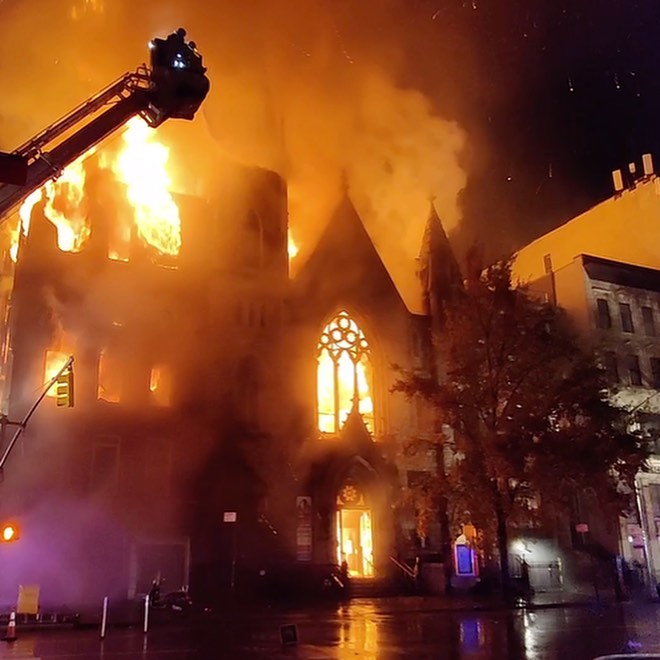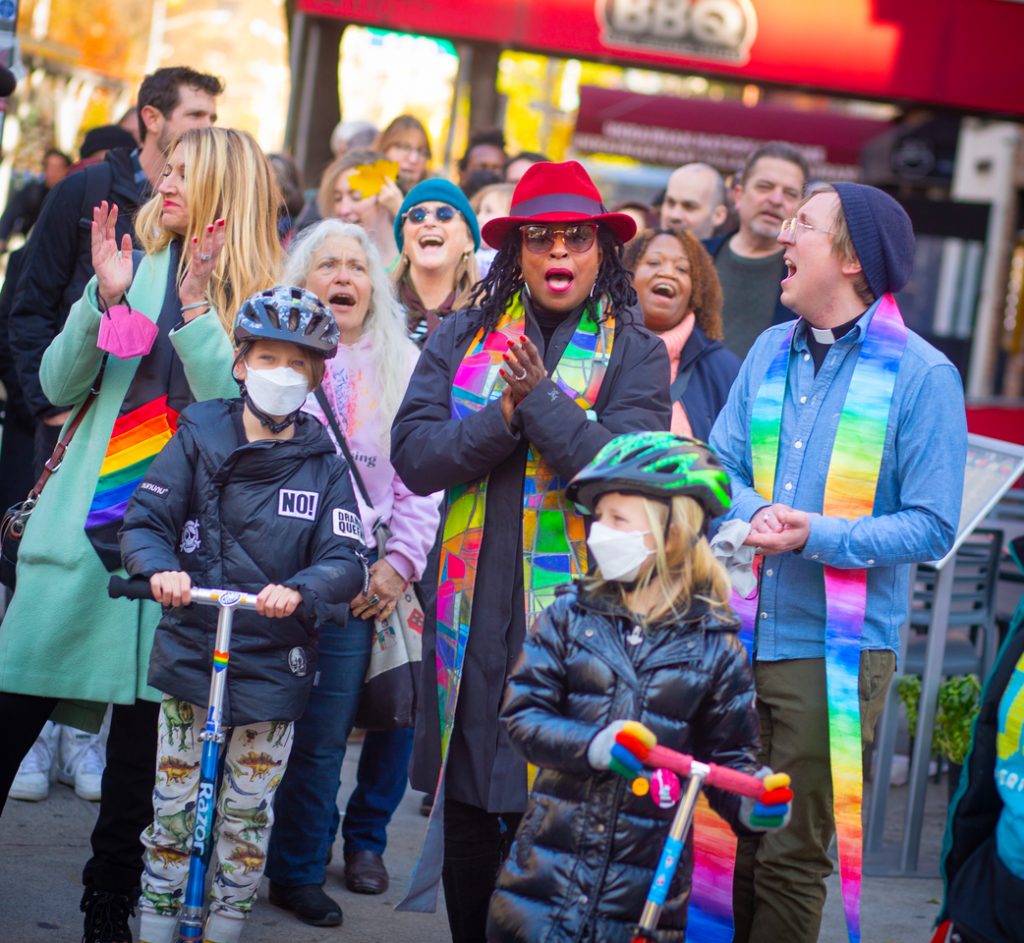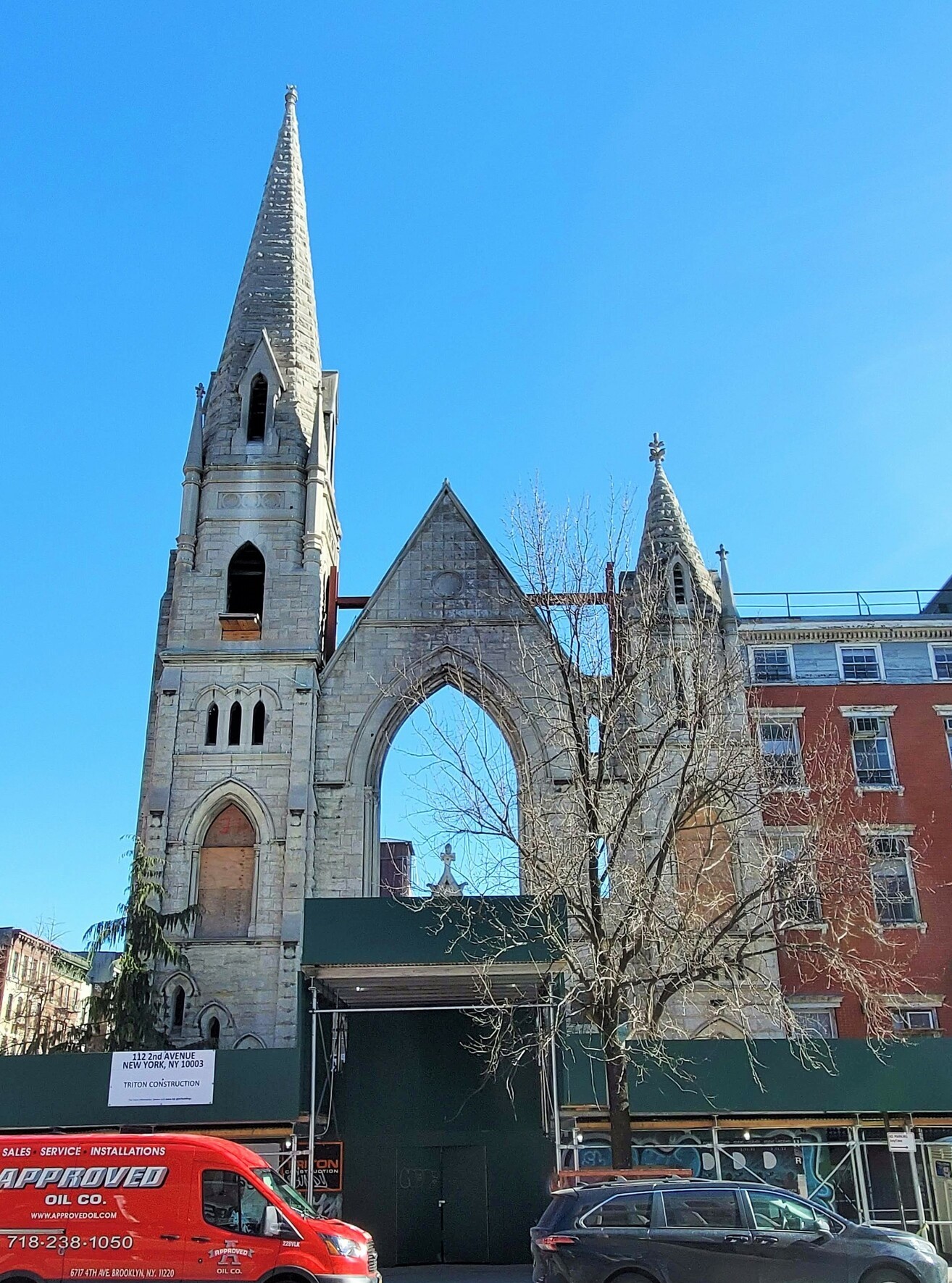BY LINCOLN ANDERSON | Updated Nov. 22, 11:30 a.m.: To quote from Ecclesiastes (and The Byrds), there is “a time to tear down, and a time to build.”
Those times — and in that order — should start now, according to Reverend Dr. Jacqui Lewis, the senior minister at Middle Collegiate Church.
Two years ago, on Dec. 5, 2020, a six-alarm inferno — sparked at a vacant property next door — tore through and gutted the 1892 Protestant church, located at Seventh Street and Second Avenue.
After the disaster, some of the historic house of worship’s facade was still left standing. According to Lewis, the church has tried to see if the remaining facade can be incorporated into a new building on the site, but it’s proven simply unfeasible. And what is left of the building was severely damaged by the blaze, she said.
“The tracers — the windows, the fabric that’s left — is not what it was,” Lewis said, “tracers” referring to the stone bars or ribbing that divides windows into sections. “We can say the facade didn’t burn down, but it’s burned up.”

In fact, the church spent more than $4 million over the past two years to clean up the site, stabilize the facade, test it and see what could be done or preserved of it, according to the minister. Drones were even flown around inside the space to investigate the stonework’s viability.
Changing temperatures, from hot to cold, have been wreaking further havoc on the building’s damaged brickwork, she said. Special paint has been applied in vain to try to seal the exposed bricks from the elements.
“And it’s deteriorating now,” Lewis said of the remaining structure. “Our engineer says it’s unsafe because it’s deteriorating. I’ve invested $4 million to hear that it’s unsafe.”
In short, rebuilding on the site with the facade remnant would be too dangerous, Lewis said the church has been advised by its engineer.
The pandemic struck a few months after the church fire, and services were then held remotely. More recently, the congregation has been meeting in person at East End Temple, at 17th Street and Second Avenue.
Basically, for Middle Collegiate to stay in the East Village location, the facade must come down, Lewis said.
“It was not our plan, but it feels like the right thing to do,” she said. “My neighbors and our congregation wanted to stay in the East Village.”
The three other Manhattan churches in the Collegiate consortium, as it’s known — Marble Collegiate, West End Collegiate and Fort Washington Collegiate — urged Middle Collegiate to just move their congregation into one of their existing churches. But Lewis said she and her flock firmly wanted to remain in the neighborhood.
“We pushed to stay Downtown,” she said.
She noted that Middle Collegiate — which is a “justice forward” church — also looked at other nearby sites to possibly buy or lease but nothing was suitable.

“We’re the ones who are 400 years old, and of course we like our history,” she said of the Collegiate congregation, which got its start in colonial New Netherland. “That building is built in 1892. And we’re the ones who had the fire. And I didn’t burn it down — the neighbor burned it down.”
Asked how the the church would rebuild on the site, if allowed to demolish the facade, she said, “We will rebuild something beautiful that is totally appropriate for our historic community — to serve the community — art, justice, childcare, theater, clothing distribution, queer organizing, Black Lives Matter. We’re committed to an identity as a welcoming, inclusive, arts, bold expression of God’s love on the planet. And,” she stressed, “the facade can’t be a barrier to that.”
However, Middle Collegiate first needs the O.K. from the city’s Landmarks Preservation Commission to raze what’s left of the church, since it’s located in the East Village/Lower East Side Historic District. A hearing at L.P.C. is set for this Tues., Nov. 22, starting at 9:30 a.m.
On the other hand, Village Preservation opposes the demolition of the ruined facade and says alternatives need to be studied.
“We are urging the Landmarks Preservation Commission not to grant such permission at this time, because we don’t believe there is sufficient documentation that alternatives to preserve the historic facade have been fully explored, nor that there is sufficient evidence at this time to justify the permanent and irreversible removal,” Village Preservation said in an e-mail release. “We are calling for further examination and documentation before such a decision would be appropriate to render.
“We want to see the church rebuild and flourish at this location, and know that they have been through incredible hardship,” the statement continued. “But we also believe that this process must be considered extremely carefully, to ensure unchangeable decisions that could have been avoided are not made, and harmful precedents are not set for allowing demolition of historically significant structures without reasonable and achievable proof of the necessity of doing so.”
However, Lewis said the church’s engineer has been analyzing the structure and possible scenarios for the past 18 months, whereas an engineer contracted by L.P.C. only dropped by recently for a quick look.
Indeed, Erik Madsen of Madsen Consulting Engineering did an inspection of the church for L.P.C. on Oct. 24, plus a follow-up visit on Nov. 11 via the sidewalk in front. In a letter to John Weiss, the L.P.C. deputy counsel, on Nov. 15, the independent engineer wrote, in part, “At this point, there is insufficient evidence to state that the structure is other than globally stable and able to be further stabilized through an investigation and remediation.”
In addition, Andrew Berman, executive director of Village Preservation, noted that “neither denying this application at this time will prevent the church from rebuilding here nor will granting it at this time ensure that they will rebuild at this location, as there is currently no rebuilding plan. I’ll add that apparently the ultimate decision about whether or not the church will rebuild at this location lies with the Middle Collegiate Corporation, which owns the land, not this congregation. It is unclear how committed the corporation is to allowing this congregation to rebuild here.”
Berman added that, were the building deemed to be in a dangerous condition, the Department of Buildings would have already ordered its complete demolition. Also, he noted, Middle Collegiate could file a “hardship application,” regarding the financial burden of rebuilding with the old facade still in place, yet has not done so.
In addition, the East Village Community Coalition, Lower East Side Preservation Initiative and Historic Districts Council have all independently reviewed the church’s application to L.P.C. and agree with Village Preservation that it doesn’t, as of this stage, qualify for approval.
“H.D.C. is excited to see Middle Collegiate Church rebuild and flourish at 112 Second Ave. for many years to come,” the Historic Districts Council said. “As East Village neighbors, we are keenly aware of the toll the fire has taken on Middle Collegiate, and the East Village community, but we find an application to demolish the church’s facade to be inappropriate at this time.”
However, if Middle Collegiate is to stay in the community, clearing the site is imperative, Lewis maintained.
“It is a tough decision,” she said. “We do not make the decision lightly.”
If L.P.C. does not allow the structure’s demolition, it would put the church in a serious bind, as the reverend tells it.
“What we don’t want is the facade standing there with condos behind it,” she said. If the city nixes the demolition, she warned, “We might not have any choice but to liquidate the site and let someone else have it.”


I am a member of Middle Collegiate Church and Village Preservation. I have attended almost all of the zoom meetings regarding the rebuilding. I stand with Rev. Lewis. A tremendous amount of time and money and research has already been invested into the situation after the tragic fire. I want Middle Church to rebuild on that site and remain a sanctuary and resource for the neighborhood.
I’m curious where Berman gets his notion that the Collegiate Corporation might not support rebuilding on that site. Sounds like pure speculation on his part. I have not missed the irony that Rev. Lewis and Middle Church were recently honored by Village Preservation, whose current stance may drive the church from rebuilding on Second Ave.
One correction: Middle Church is not an Episcopal church.
The notion that the support of the Collegiate Corporation for rebuilding at this site is not guaranteed comes from Middle Collegiate itself, which has made that explicitly clear, including in today’s presentation at the Landmarks Preservation and in their presentation to us and other groups. They have repeatedly noted that the corporation has the ultimate decision here about rebuilding, and that their support for rebuilding here is not guaranteed. The corporation has also sold off other church properties in Manhattan for development.
We also want Middle Collegiate to rebuild at this site and remain a sanctuary and resource for the neighborhood, at this location; approving this application would not ensure that, and denying the application — which would allow the church to then file a hardship application — would not prevent it.
The application the church is currently filing requires a finding that the facade is unsalvageable or makes rebuilding impossible; that clearly has not yet been established, and is contradicted by the findings of both the independently commissioned engineer and the Department of Buildings.
A hardship application, on the other hand, would only require the church to demonstrate that maintaining the facade is not compatible with fulfillment of its mission — a much different standard than the requirements of the current application they are filing. In fact, procedurally, the church needs to file this current application and to be turned down in order to file a hardship application.
Perhaps there is a 3D printing technology that could be used to exactly replicate the facade if indeed the facade must be torn down.
With all due respect to the congregation’s professional team, this building’s facade definitely deserves the kind of in-depth inspection and analysis that only a seasoned preservation architect or engineer can provide. We at Lower East Side Preservation Initiative are sympathetic to the very real challenges the congregation faces here. But the building has been an architectural and spiritual beacon for the neighborhood for over a hundred years, and is one of the most important sites in the historic district. We just want to make sure that the Landmarks Commissioners have the best information and all the options spelled out before deciding on the building’s fate.
Are you going to pay for “the kind of in-depth inspection and analysis that only a seasoned preservation architect or engineer can provide”? Have you talked to the congregation’s team and reviewed their analysis? If so, are there specific aspects of it that you think are deficient?
What an outrageous and shameful position by Village Preservation. The congregation has already spent $4 million. Is Village Preservation going to pay for “further examination and documentation?” It’s been two years. This community made their decision about their property after serious consideration and Village Preservation should respect it.
As always, this anonymous commentor who is afraid to reveal their identity is untethered to the truth. We’re not asking the church to spend a single extra dollar on further examination and documentation. That should and must be done by an independent entity, in this case the Landmarks Preservation Commission, the city agency with oversight on this matter. In fact, the LPC has hired and brought in an independent engineer to do an evaluation, and they found the evidence did not currently support the claim of a lack of safety by the facade remaining up or a lack of feasibility to it being reused as part of a new building. The Department of Buildings has examined the site and not found it structurally unsound or presenting a danger. As we pointed out, if the church wants to make the case that maintaining the facade is either financially unfeasible for them or inconsistent with their mission, they can file a hardship case to demonstrate. That will require this current demolition application being rejected, which — based on the lack of supporting evidence at this time — it should be.
Have you even talked to the church, Andrew? It sure doesn’t sound like you have. And how dare you call me “untethered to the truth,” when you claim filing a hardship application won’t cost them another dollar. They would have to hire lawyers, consultants, etc. And if they do manage to file that, you’ll be there to testify against their hardship application, just like you did at St. Vincent’s Hospital.
You’re a sad man who got passed over for elected office and can’t afford to live in the neighborhood he grew up admiring. As a result you chose to devote your life to protecting buildings instead of people. Shame on you.
We’ve had and continue to have extensive conversations with the church about this, with whom we’ve met at length about this. Glad to see, as always, you’re keeping this fact-based rather than making ad hominem personal and anonymous attacks.